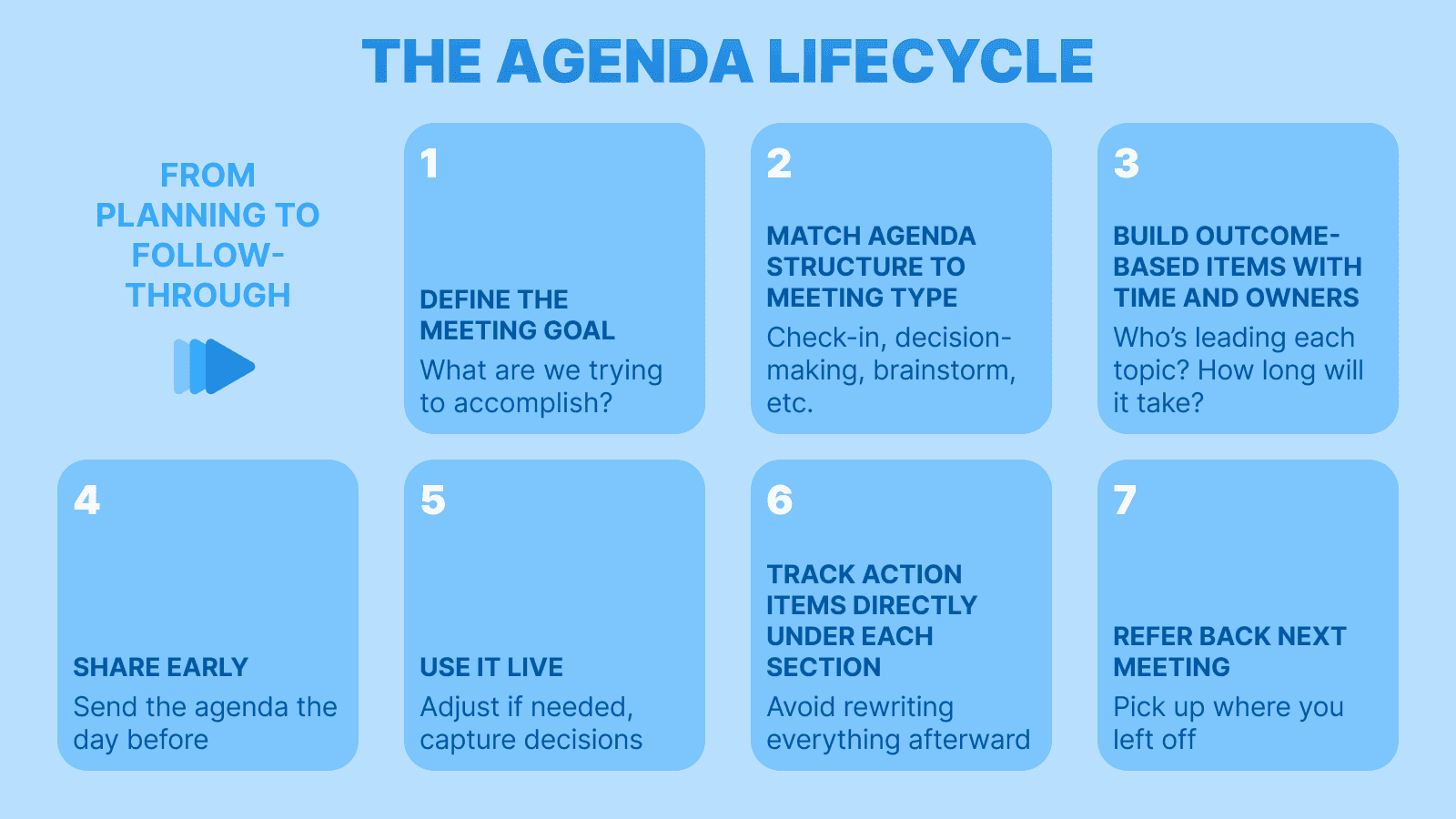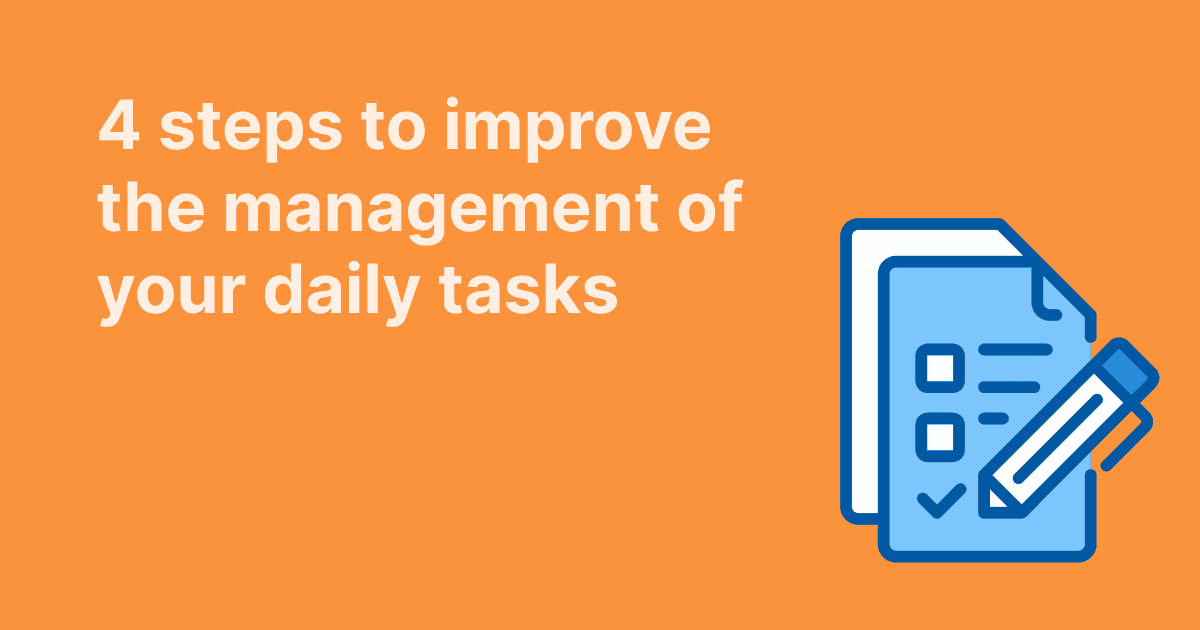If your meetings are dragging or worse, ending with more confusion than clarity, the problem probably started before anyone joined the call. Most teams don’t struggle with talking. They struggle with focus. And that starts with how you plan the meeting.
An effective meeting agenda is what keeps the conversation on track, the goals in sight, and the meeting time under control. Without it, you’re relying on memory, improvisation, and hope.
In this post, we’re breaking down how to create an agenda that works. Not one that just fills space, but one that drives outcomes. You’ll learn how to define your purpose, choose the right amount of time, structure discussion points, and set your team up for real progress.
What Is a Meeting Agenda, Really?
Before we move forward, let’s clarify what the meeting agenda even is. A meeting agenda outlines what you’re going to talk about, in what order, and how much time you’ll spend on each topic. But more than that, it’s a tool for making meetings intentional.
At its best, a meeting agenda does three things:
- Clarifies the purpose of the meeting
- Guides the discussion so people stay on topic
- Keeps the meeting time in check
It also gives everyone a chance to prepare, so you're not spending half the call just getting people up to speed. Whether it’s two bullet points or a fully structured outline, a meeting agenda should help your team move forward, not just fill the hour.

Define the Purpose Before You Write a Word
No agenda should start with “what should we talk about?” It should start with why you’re meeting in the first place.
That purpose is the anchor. It’s what helps you decide who to invite, what to include, and how to guide the discussion. A vague goal like “check in on progress” doesn’t give anyone a reason to show up prepared. A clear purpose like “agree on final pricing structure for Q3 launch” tells everyone what the finish line looks like.
If you can’t define the goal, don’t create the agenda, cancel the meeting. That’s not a failure. It’s a time-saving win. So before you even think about listing topics, write down the outcome you’re aiming for. Then build everything else around it.
Align the Agenda with the Meeting Type
Not every meeting needs a ten-point plan. Some need structure. Others need space. The key is knowing the difference.
Before you create an agenda, take a step back and ask: What kind of meeting is this?
A quick check-in? A decision-making session? A team-wide deep dive? Each of these requires a different level of detail, pacing, and time commitment. Cramming the same structure into every format is how short meetings turn long, and long meetings turn painful.
For example:
- One-on-ones work best with a few open-ended prompts and room for discussion.
- Project reviews need clearly defined talking points and time frames.
- Brainstorming sessions should include guardrails but leave flexibility for idea flow.
- Decision-focused meetings benefit from a tight agenda that outlines key questions, owners, and expectations.
A productive meeting agenda doesn’t just list topics, but matches the format to the purpose and fits within a realistic amount of time. If the structure doesn’t support the outcome, the meeting won’t either.
Break Down Topics into Actionable Segments
A list of discussion topics isn’t a meeting agenda. Not a useful one, anyway.
If you want your meetings to stay focused and lead to real outcomes, each item on the agenda needs to be actionable. That means going beyond labels like “budget,” “product update,” or “customer feedback.” Those are categories, not direction.
Start by reworking broad topics into clear, outcome-driven prompts. For example:
- Instead of “budget,” write “Finalize Q3 campaign allocations”
- Instead of “product update,” use “Decide whether feature X is ready for rollout”
- Instead of “customer feedback,” try “Identify top 3 issues from support tickets to prioritize next sprint”
This shift does two things:
- It gives participants a clear sense of what they’re expected to weigh in on.
- It makes it easier to tell when the discussion is finished, because there’s a decision, answer, or action coming out of it.
Framing your agenda around prompts like “What do we need to decide?” or “What’s blocking us from moving forward?” turns your meeting into a working session, not a wandering conversation. And if a topic doesn’t have a clear outcome? It probably doesn’t belong on the agenda. At least not this time.
A good rule of thumb: If you’re adding an item to the meeting agenda, ask yourself what needs to happen as a result of talking about it. If there’s no clear answer, it might not belong in the meeting.
Estimate Time Frames Thoughtfully
Time is one of the easiest things to mismanage in a meeting and one of the hardest to get back once it's gone. That’s why assigning time frames to each agenda item matters.
You don’t need to calculate down to the minute, but every agenda should include a realistic estimate of how long each item will take. This keeps the conversation moving and helps prevent less important topics from eating up the entire meeting.
Start with a rough total: How much meeting time do you actually have? Then, break it down by priority. High-impact items, like key decisions or blockers, should go earlier in the agenda and be given enough breathing room. Informational updates or less urgent items can come later and be time-boxed more tightly.
For example:
- 5 minutes: Quick status update
- 20 minutes: Discuss launch blockers and assign owners
- 10 minutes: Align on messaging changes for the sales deck
- 5 minutes: Review next steps and assign action items
It’s also smart to build in a small buffer at the end. That way, if a discussion runs long, you don’t lose the final five minutes that should’ve gone to confirming who’s doing what. Being deliberate about time shows respect for your team’s schedule and forces you to clarify priorities, which leads to more productive meetings, even when time is short.
Assign Roles and Owners Before the Meeting Starts
Every agenda item should have a clear owner. This doesn’t mean one person has to do all the talking, but someone should be responsible for introducing the topic, sharing any necessary context, and guiding that part of the discussion. Without ownership, conversations tend to stall or drift.
Clarify this before the meeting begins:
- Who’s leading each topic?
- Who’s taking notes?
- Who’s responsible for capturing action items and decisions?
Assigning roles doesn’t need to be complicated. In small, recurring meetings, it may be the same person every time. In larger or cross-functional sessions, it helps to rotate responsibilities or assign based on who brings the most context.
You’ll also want to identify a facilitator. Their job is to keep the agenda on track, manage the flow of conversation, and step in if time runs over or discussion gets stuck. In some cases, this will be the meeting organizer. In others, it may be a neutral lead who can keep things focused.
When people know what they’re responsible for going in, they show up prepared and your meeting runs smoother from the first minute.
Share the Agenda Early and Revisit It Live
Once the agenda is built, don’t keep it to yourself. The earlier your team sees it, the more effective the meeting will be.
Circulating the agenda ahead of time, ideally the day before, gives participants space to review what’s on the table and prepare accordingly. It also opens the door for feedback. Someone might catch a missing item, suggest a better order, or offer input that helps sharpen the discussion points before the clock starts ticking.
Sharing the agenda in advance sets expectations. It tells your team: here’s what we’re here to do, and here’s how we’re going to use our time. No one should be hearing the meeting’s purpose for the first time when the call begins.
Once the meeting starts, revisit the agenda briefly. Ask:
- Does this plan still make sense?
- Are there any last-minute changes that need to be acknowledged or reprioritized?
Even a quick check-in helps anchor the group before diving in. And if something comes up mid-meeting that wasn’t on the agenda? Note it, park it, and keep the meeting focused on what matters now. You can always address new issues at the end or in a follow-up.
The agenda doesn’t just guide the meeting, it helps protect it. From distraction. From drift. From wasted time.
Use the Agenda to Drive Follow-Through
The meeting might end, but the work rarely does. That’s why your agenda should do more than guide the conversation, it should support what happens next.
As the meeting unfolds, capture notes directly within the agenda itself. Add action items beneath each section, tag owners, and clarify deadlines while the details are still fresh. If you’re using a tool like WEDO, this can happen in real time, no need to create a separate recap after the fact.
It also helps reduce duplication. Instead of rewriting what was discussed into a new doc or follow-up email, the agenda becomes the single source of truth. Everyone knows where to find the context, the decisions, and what they’re responsible for.
And when the next meeting rolls around? You’ve got a record to refer back to and a head start on planning the next agenda.

How WEDO Helps You Build Better Agendas
Everything in this guide becomes easier and more consistent when you use the right tool.
WEDO is built for teams who want to stop repeating conversations and start making real progress. With WEDO, you can plan, structure, and manage your meeting agenda all in one place, before, during, and after the call.
Here’s how it helps:
- Create and share agendas fast using a collaborative workspace that’s linked to each meeting
- Assign owners and time frames to every item, so responsibilities are clear and the meeting stays focused
- Take notes in real time directly inside the agenda view, no switching between tabs or apps
- Track decisions and action items as they happen, and carry them forward to the next meeting
- Revisit agendas and outcomes easily, with everything stored and searchable in one shared timeline
No more scattered notes, lost follow-ups, or guessing what happened last time. WEDO makes it easy to build habits around structured, productive meetings, and to keep your team aligned every step of the way.
Ready to see it in action? WEDO helps you turn better planning into better outcomes. Try it out for free and see how much time and momentum you can save.



